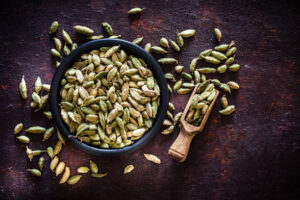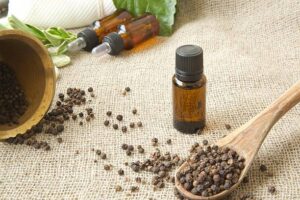Taken from the 15th century CE classic Ayurvedic text Bhava Prakasha written by the ancient physician Bhava Misra, the recipe for sarkarodaka utilises fresh red cane rock sugar, fresh clean water, green cardamom seeds/elaichi, cloves/lavanga, and karpur
The heat of summer makes the body uncomfortable with the excess sweat and captured heat. Today's good living gives us several choices, using technology and modern convenience to lure us into air-conditioned rooms, drink ice cold water, enjoy frozen fruit drinks, ice-creams and plunge into chlorinated swimming pools. Visuals lure us into an illusion that these will keep us safely cool.
Ayurveda advised that only foods that produce cooling inside will actually cool our body. The ancient texts of Ayurveda gave us the original sweet cooling drinks, from which today's modern cold drinks have evolved, preparations that use ingredients that actually cool the body without halting the metabolism inside, essentially reducing radiant heat loss from each cell's factory. These sweet cooling drinks are known as pānaka, described in the pākaśāstra, texts of Ayurveda devoted to the topics of dietetics, culinary arts and the science and art of cooking (paka, S., to cook).
Pānaka (पानक, S., syrup) are cooling drinks that expel the thirst that comes from excess perspiration and loss of body water. Sarkarodaka is an excellent pānaka for replenishing the body's water, while eliminating that thirst.
Taken from the 15th century CE classic Ayurvedic text Bhava Prakasha written by the ancient physician Bhava Misra, the recipe for sarkarodaka utilises fresh red cane rock sugar, fresh clean water, green cardamom seeds/elachi, cloves/lavanga, and karpur.

Red Cane Sugar
The main medicinal herb in this preparation is fresh sugar cane solidified into crystals. When unbleached it has a reddish tinge due to minerals in the whole cane sugar, and when it is made using a low slow fire, it naturally crystallizes into rock sugar called sarkara; this is chemically interpreted differently in the body than granulated sugar which is heated and minerals are eliminated to give chemically pure sucrose which holds a lot of heat and energy within its chemical bonds. Due to their differing chemical constituents and quaternary structures, they have different effects on the body.
Fresh clean water that has not been ripped of its minerals through an RO or chemical process is the best water for the body. Pure water from nature is regularly advocated by Ayurveda, given a mild boil to eliminate pathogens.
Spices
The spice ingredients are chosen for their specific medicinal properties. Elaichi, known as green cardamom pods (ēlā, S.) increases digestive fire, called deepana, and also promotes pachana, digestion of food sitting in the gut undigested. It sends urine down and out, if retention or flow is an issue, known as mutrala. The seeds are released from the pod just before use, and ground in stone mortar and pestle.
Lavaṅga/cloves are also deepana, increasing digestive fire; mutrala, aiding proper urination; ruchikara, increasing the flow of taste at the level of the tongue, and also improving the appetite for food; durgandha-nasaka, helping to rid foul smell from the mouth; and krimighna, destroying parasitic infections and microbes that persist in imbalanced amounts in the mouth.
Karpoor/camphor is known for its properties of reducing vata, reducing coughing, known as kasahara; and reducing fever, known as jwaraghna. Like elaichi and lavanga, camphor is also deepana, increasing digestive fire.
Marica/black pepper has the quality of both deepana an pachana, like elaichi. It is shwashara and kasahara, opening the respiratory channels to relieve asthma (shwasa) and coughing (kasa). It is famous for its ability to stir and clear obstruction of mucous and phlegm from the channels of the body, known as pramathi.
*************************************
शर्करोदक
जलेन शीतलेनैव घोलिता शुभ्रशर्करा |
एलालवङ्गकर्पूरमरिचैश्च समन्विता |
शर्करोदकनाम्ना तत्प्रसिद्धं विदुषां मुखैः ||१२८||
शर्करोदकमाख्यातं शुक्रलं शिशिरं सरम् |
बल्यं रुच्यं लघु स्वादु वातपित्तप्रणाशनम् |
मूर्च्छाछर्दितृषादाहज्वरशान्तिकरं परम् ||१२९||
Bhava Prakasha Nighantu, kṛtanna varga, chapter 12, slokas 128-129
Transliteration: śarkarodaka
jalēna śītalēnaiva ghōlitā śubhraśarkarā |
ēlālavaṅgakarpūramaricaiśca samanvitā |
śarkarōdakanāmnā tatprasiddhaṁ viduṣāṁ mukhaiḥ ||128||
śarkarōdakamākhyātaṁ śukralaṁ śiśiraṁ saram |
balyaṁ rucyaṁ laghu svādu vātapittapraṇāśanam |
mūrcchācharditr̥ṣādāhajvaraśāntikaraṁ param ||129||
Translation:- The water which is prepared by mixing red rock cane sugar (śarkara) with water (udaka) and then mixed with cardamom (ēlā), cloves (lavaṅga), camphor (karpūra) and black pepper (marica) in equal quantity, is called śarkarodaka.
*************************************
Śarkarodaka helps sperm count, produces a healthy appetite, and enhances strength. It increases the capacity to taste. It is known to decrease vata and pitta dosha. Its inherent properties are sweet in taste, cooling in nature and easy to digest. It can cure rakta dusti, the condition of having disturbed doshas in the blood. It also intervenes on fainting/delirium, vomiting, excess thirst, burning sensation, and fever.

Ingredients:
Fresh red cane sugar - 20g (about 4 tsp)
Fresh clean water - 1 litre
Elachi/green cardamom pods, fresh ground - 1g
Lavanga/cloves, fresh ground - 1g
Karpur/camphor - 1g
Black pepper, fresh ground - 1g
Recipe:
Add 1000ml clean, fresh water into a clean vessel. Add 4 teaspoons red cane sugar that has been freshly ground to powder. Stir until the sugar has completely dissolved into the water.
Then add about 1 gram of freshly ground seeds from 3-4 green cardamom pods. Add about 1 gram of freshly ground flower buds of cloves, and about 1 gram of camphor. Add freshly-ground black pepper (golmorich, kali mirch, marica, Piper nigrum). Stir well for five minutes, adding prayers for good health. Serve with a smile in glasses, with rims lined with ground cane sugar.








